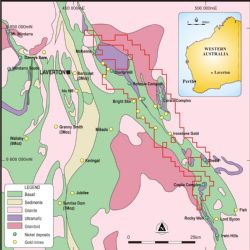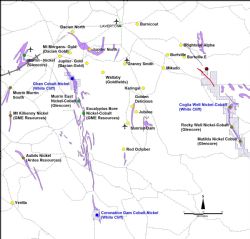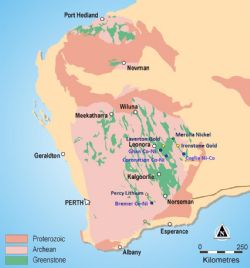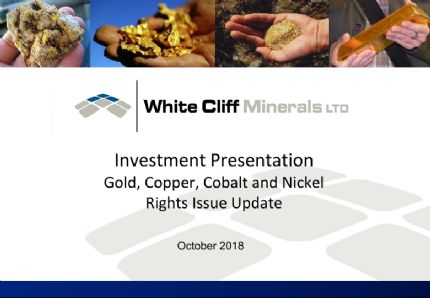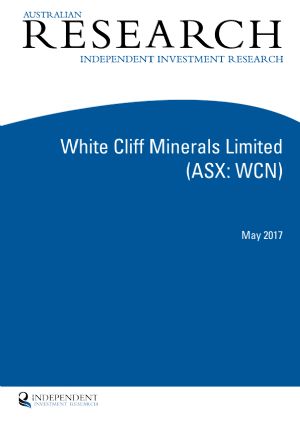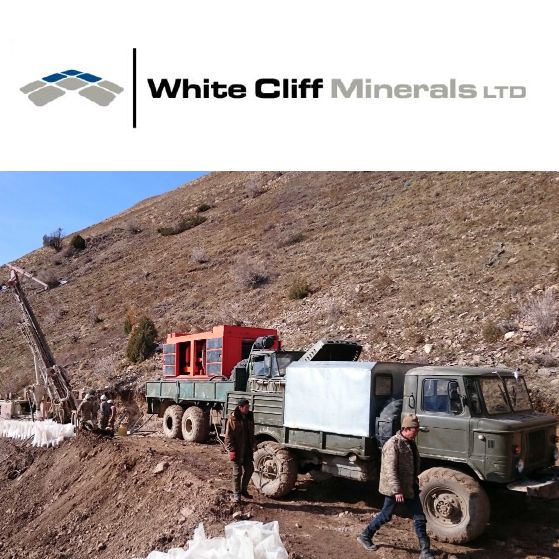
Further Cobalt, Nickel and Copper Mineralisation Intersected
Perth, July 9, 2018 AEST (ABN Newswire) - White Cliff Minerals Limited ( ASX:WCN) ("White Cliff" or the "Company") is pleased to provide an update on exploration drilling conducted at its 100%-owned Coglia Well cobalt-nickel project near Laverton in the Western Australian goldfields.
ASX:WCN) ("White Cliff" or the "Company") is pleased to provide an update on exploration drilling conducted at its 100%-owned Coglia Well cobalt-nickel project near Laverton in the Western Australian goldfields.
Highlights:
- Drilling identifies further cobalt, nickel and copper mineralisation including:
o 4 metres at 0.11% cobalt, 3.20% nickel and 314ppm copper from 43 metres including;
-- 3 metres at 0.12% cobalt, 3.85% nickel and 346ppm copper
-- Single metre cobalt grades of 0.41% and 0.36% cobalt
o 2 metres at 0.38% cobalt and 1.05% nickel from 65 metres
o Multiple holes ended in mineralisation
- Highly anomalous copper assays suggestive of sulphide mineralisation including;
o 23 metres at 1,024ppm (0.1%) copper from 22 metres
o 33 metres at 527ppm copper from 18 metres
Drilling intersected substantial cobalt-nickel mineralisation in several consecutive holes extending across a width of 850 metres with assay results including:
CGAC0044: 4 metres at 0.11% cobalt and 3.20% nickel from 43 metres (hole ended in mineralisation) including;
3 metres at 0.12% cobalt, 3.85% nickel and 346ppm copper
CGAC0037: 2 metres at 0.38% cobalt and 1.05% nickel from 65 metres depth (hole ended in mineralisation)
CGAC0045: 6 metres at 0.75% nickel, 0.02% cobalt from 33 metres (hole ended in mineralisation)
CGAC0047: 16 metres at 0.53% nickel, 0.01% cobalt from 37 metres (hole ended in mineralisation)
CGAC0048: 10 metres at 0.66% nickel, 0.01% cobalt from 47 metres (hole ended in mineralisation)
CGAC0035: 1 metre at 0.04% cobalt and 0.85% nickel from 70 metres depth (hole ended in mineralisation)
Drilling also intersected significant copper mineralisation including; 23 metres at 1,024ppm copper in CGAC048 and 33 metres at 527ppm copper in CGAC047. Copper mineralisation tends to concentrate in the regolith profile at the top of the water table; however, the grades encountered are highly anomalous and may be associated with a sulphide source.
As with the previous announcement several holes ended in cobalt-nickel mineralisation but drilling did not consistently penetrate the silica layer immediately above the main cobalt-nickel mineralised zone. The air core drilling equipment was unable to penetrate the silica layer and did not penetrate to the deeper parts of the mineralised zone that occurs from 75-95 metres deep. Due to hard ground conditions further drilling programs will be conducted with a larger drill rig.
White Cliff Managing Director Todd Hibberd said: "The final batch of assay results from the Coglia cobalt project has identified more cobalt and nickel mineralisation at significant grades including 3 metres at 3.85% nickel 0.12% cobalt and 346ppm copper. The identification of highly anomalous copper grades (23 metres at 1,024ppm Cu) and nearby nickel grades up to 4.23% nickel is suggestive of a nearby sulphide source for the mineralisation. The copper anomalism appears to increase towards the contact between the ultramafic unit and the underlying felsic volcanic rock, the classical position for nickel-copper sulphide mineralisation. The Company is currently planning follow up drilling."
Cobalt and Nickel Mineralisation
Laboratory assay results for sections 6,789,520N and 6,788,880N identified cobalt and nickel mineralisation over widths up to 16 metres. Mineralised intervals include:
CGAC0044: 4 metres at 0.11% cobalt and 3.2% nickel from 44 metres (hole ended in mineralisation) including;
3 metres at 0.12% cobalt, 3.85% nickel and 346ppm copper
CGAC0037: 2 metres at 0.38% cobalt and 1.05% nickel from 65 metres depth (hole ended in mineralisation)
CGAC0045: 6 metres at 0.75% nickel, 0.02% cobalt from 33 metres (hole ended in mineralisation)
CGAC0047: 16 metres at 0.53% nickel, 0.01% cobalt from 37 metres (hole ended in mineralisation)
CGAC0048: 10 metres at 0.66% nickel, 0.01% cobalt from 47 metres (hole ended in mineralisation)
CGAC0035: 1 metre at 0.04% cobalt and 0.85% nickel from 70 metres depth (hole ended in mineralisation)
Other holes completed on these lines include:
MERC005: No significant assay, not drilled deep enough
MPRC006: 5 metres at 0.60% nickel (no cobalt assays) from 69 metres (ended in mineralisation)
MPRC007: 8 metres at 0.85% nickel (no cobalt assays) from 49 metres (ended in mineralisation)
MPRC008: 8 metres at 0.85% nickel (no cobalt assays) from 49 metres (ended in mineralisation)
Cobalt mineralisation occurs as a flat sub-horizontal layer in the regolith profile slightly above and overlapping with nickel mineralisation approximately 16-20 metres thick and 30-60 metres below the surface.
In general, several holes ended in cobalt-nickel mineralisation but drilling did not consistently penetrate the silica layer immediately above the main cobalt-nickel mineralised zone. The air core drilling equipment was unable to penetrate the silica layer and did not penetrate to the deeper parts of the mineralised zone that occurs from 75-100 metres deep. Due to hard ground conditions further drilling programs will be conducted with a larger drill rig.
Copper Anomalism
Drilling intersected significant copper mineralisation including:
- 23 metres at 1,024ppm (0.1%) copper in CGAC048 and;
- 33 metres at 527ppm copper in CGAC047
The copper mineralisation increases in intensity to the west towards the contact between the intrusive ultramafic unit and the adjacent felsic volcanic rocks. While copper mineralisation tends to concentrate in the regolith profile at the top of the water table the elevated levels of copper (up to 0.2%) are suggestive of nearby sulphide mineralisation.
The Company is planning follow up drilling.
About the Coglia Well Nickel-Cobalt Deposit
The Coglia ultramafic complex covers an 11.5 kilometre by 1.5 kilometre area and is part of a 100 kilometre-long trend of ultramafic rock running from Diorite Hill in the north to Mulga Tank in the south. At Coglia Well, approximately 2.5 kilometres of the 11.5 kilometres of strike have been partially drill tested, resulting in the identification of extensive cobalt and nickel mineralisation.
Drilling has been undertaken on wide spaced lines generally 650 metres apart with holes spaced at 320-metre intervals. The 2018 drilling program has infilled this to 160 metre hole spacing. Cobalt and nickel mineralisation occurs on all lines between 30 and 80 metres depth. Mineralisation has developed in the regolith profile above a weathered ultramafic unit which was originally a dunite (an olivine rich ultramafic rock). A series of existing drill programs (2001- 2003) outlined cobalt and nickel mineralisation over a zone approximately 2.5km long by 500 metres wide and 10-15 metres thick. Mineralisation is open along strike in both directions. Drilling in 2018 has extended the mineralisation to approximately 4 kilometres long.
The cobalt grade appears to increase substantially to the south of the main mineralisation, which is consistent with the grade of Glencore PLC's adjacent Irwin Hills cobalt and nickel deposits which contain 29Mt at 0.11% cobalt and 1% nickel. A single RC hole, MERC005, drilled 2.5 kilometres south of the main mineralisation, encountered 28 metres at 0.12% cobalt and 0.55% nickel. There is a further 7 kilometres of untested prospective ultramafic rock to the tenement boundary adjacent to Glencore's deposit.
Cobalt mineralisation occurs as a shallow layer of manganiferous oxides that form between the smectite clays and the overlying ferruginous clays. High grade cobalt mineralisation typically occurs between 30-50 metres depth and is associated with nickel mineralisation. The cobalt mineralisation generally occurs slightly higher than nickel mineralisation in the regolith profile.
At Coglia Well there is substantial nickel mineralisation and the cobalt mineralisation discussed above has formed from the same processes. The Company believes that the cobalt mineralisation has the potential to economically extractable in its own right. The proximity of the project to Glencore's Murrin-Murrin nickel-cobalt processing plant is likely to strongly impact the possibility of economic development of both the cobalt and nickel mineralisation.
While White Cliff has not yet calculated any mineral resources it is clear that potential exists for a substantial resource. Historic drilling has only tested a small fraction of the mapped ultramafic unit indicating there is potential to locate significant additional mineralisation.
Regional Infrastructure
The Coglia Well nickel and cobalt deposit occurs in a region hosting multiple mining operations that have substantial existing infrastructure such as roads, telecommunications, power and gas and with access to a skilled mining workforce. The project is located 130km via road from Glencore's Murrin Murrin nickel-cobalt processing plant and is adjacent to their Irwin Hills nickel-cobalt deposit. The region is well serviced by transport services and airports.
To view tables and figures, please visit:
http://abnnewswire.net/lnk/N7ZWL655
Contact
Todd Hibberd
Managing Director
T: +61-8-9321-2233
E: info@wcminerals.com.au
W: www.wcminerals.com.au
| ||
|



